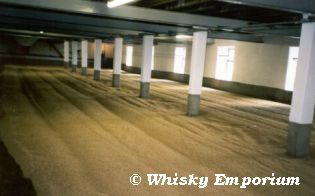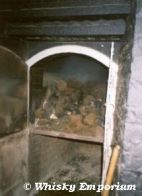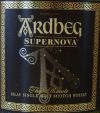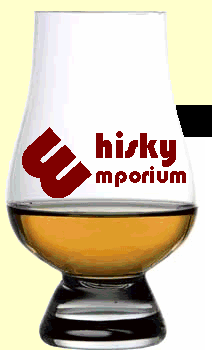|
Monday 12th April; The Big Grouse or "A foursome with a
Famous Scottish bird?"
"The
Grouse" was created in 1896 by Matthew Gloag a Scottish grocer
and wine merchant from Perthshire who chose to name his whisky
after this iconic bird rather than himself. In 1905, thanks to
the popularity of the brand he added the word "Famous" to the
name.
Today
this still has the reputation of being a quality blend with a
very smooth character, so last night I decided to put the bird
to the test with four different expressions; Famous, Black, Snow
& Scottish Oak.




Famous
Grouse has a reputation for being smooth, inoffensive and very
drinkable, but what about the others?
First up
was indeed the "Famous" and although it lacked complexity,
it did exactly what it says on the label; Smooth!
Second
was the "Black" and once aain I was surprised by the
smoothness and gentleness of this expression which is the peaty
one of the family. Its gentle manner of caressing the palate was
quite a surprise for a peaty whisky, but a very pleasant
surprise indeed.
The
special release "Scottish Oak" was third and I quite
liked the rich and smooth flavours of this one which was also
quite spicy on the palate, but at the same time as the spiciness
concentrated right at the front of the palate, a strange (fruity)
sweetness hit the back. If it weren't for this sweetness this
would be a very good dram, but as it is, it just fails to hit
the spot, or should I say it hits two contrasting spots rather
than a single harmonious one.
"Snow"
was last and it is recommended to serve this one from the
freezer, so I decided to try it both at room temperature and
then from the freezer where I had left a sample for the past
week. At room temperature this offered a nose of fresh and
leathery floral detergent followed by a palate of faint, spirity
liquorice. Not impressed with this I hoped for more from the
freezer version, even though I am no fan of whisky with ice, but
this is surely different, as there's no actual ice in the whisky?
Oh dear,
the nose was, well, errmm, icy something, but too weak in
character to distinguish just what that 'something' could be. As
for the palate; one sip was enough. In fact more than enough! I
was kind and described it as "icy and most unpleasant" but if
truth were known, it comes a clear second in my all-time worst
whiskies and sits behind that
Loch Dh-ugly which I reviewed in
Dram-atics last month.
Can nothing be worse than that one?
Moving
quickly on to my conclusions; "Famous" remains an
inocuous and smooth whisky, very drinkable and liked by many for
good reasons. It also gives value for money. "Black" was
a surprise. I liked it and consider it to be a serious
alternative to the much more expensive JW Green Label. "Scottish
Oak Finish" offered some promise with flavour, but that
strange sweetness on the back of the palate rather spoiled the
party for me. As for "Snow"; Winter never was my
favourite season and although she is a rugged bird, she doesn't
deserve this treatment. So it's a case of "Been there, done that,
no need to go back for the T-shirt!"
My full
tasting notes for these expressions are available by clicking on
any of the 'Grouse' label pictures.
Friday 2nd April; Playing the ppm numbers game or "My
peat's bigger than your peat?"
Speak of
'peat' and most peoples' thoughts will probably turn immediately
to the Hebridean island of Islay and its eight working
distilleries which are primarily famous for their (often highly)
peated offerings. As if this weren't enough, two of those
distilleries have been pushing the limits as to just how much
peat they can try to cram into their bottles, or should I say
whisky?
The 'peatiness'
of a whisky is measured in ppm (Parts Per Million) and refers to
the amount of phenols which are a result of drying the barley by
peat smoke. So to blow one myth they are not, as some people
think, due to using peaty water which freely flows on the island.
The peat within the water is almost totally nullified by the
distillation process and accounts for no more than 1ppm in the
process.
To
illustrate this process are pictures of Bowmore's Maltings and
Laphroaig's Peat Oven


So,
who has how much peat, or ppm?
Ardbeg
usually has a ppm of 54-56ppm whereas in comparison Laphroaig
has 35ppm, Lagavulin 25-30ppm and Bowmore an average of around
20ppm.
But
that's not quite the end of the story as Ardbeg may have on
average 55ppm, but this is not all transferred to the final
bottled spirit, as when it reaches the bottle, after
distillation and maturation, it has been reduced to less than
half the original value and a meagre 23-25ppm.
What
about pushing those boundaries? Well, Ardbeg and
Bruichladdich seem to have been playing the ppm numbers game in
recent releases; Ardbeg with the 100ppm Supernova and then
Bruichladdich with the 140ppm Octomore 2_140 but just how 'peaty'
are these offerings? Is the Supernova really almost twice as
peaty as the standard Ardbeg 10y? Is the Octomore almost three
timesas peaty as the Ardbeg 10y, or even almost half as peaty
again as the Supernova?
I
recently had the opportunity to taste these two bottlings and
was quite surprised by my findings:
|
 |
The Supernova had a great
nose, initially fruity with mango and an element of juniper,
but as if wrapped in freshly smoked Black Forest Ham. The
palate was also richly fruity with some wood and very smooth,
but initially not much smoke or peat. This did change as I
added drops of water, to the point where the more I added,
the peatier it became. Revealing tremendous depths to the
smoky peatiness.
Final verdict: Very peaty, very drinkable, very nice |
|
The Octomore at 140 ppm
and almost half as much again as the Supernova was a totally
different whisky. The nose exhibited a rather pungent
version of what I call "Bruichladdich's Bilge Pump"; a
mixture of stale Atlantic ocean and air with hints of engine
room. This was accompanied by some fruity peat. Without
water the palate was earthy fruit and far too strong in
alcohol burn. Like the Ardbeg, adding water opened the
palate to include more depth of fruit, peat and smoke, until
it eventually included lots of rubber.
Final verdict: Quite pungent, very fruity, eventually
smoky & peaty then rubbery. |
 |
So
what conclusions can I draw?
Well,
the Supernova definitely has much more depth of peat than the
Ardbeg 10y which I am using here as my 'yardstick' for
comparison. It needs and indeed benefits from the addition of
water and it really does improve to reveal depths of peat that I
haven't experienced before. That Ardbeg 10y would have been
reduced to a watery sweetness whereas the Supernova just carried
on.
The
Octomore was also very intense, but did I identify this
intensity as peat? Not really as that pungent trait was always
at the fore and never really took off as 'peat' in the way of
other peated whiskies, although the water did help somewhat.
Can I
honestly say that I find either of these two whiskies almost 2x
or even 3x more peaty than my yardstick Ardbeg 10y? Is
either one almost 4x or even 6x more peaty than Lagavulin 16y?
Most
definitely not!
My final
comments are that we are not told how many of these magic ppm
numbers have actually been transferred to the bottle, but if
Ardbeg 10y reduces from about 55 ppm to 23 ppm in the bottle,
then I guess these are somewhere around 43 ppm and 58 ppm
respectively. But does this matter? Not really as the
comparisons are still valid in the bottled versions, so why
aren't they so much more peaty? Well I guess the 'problem' lies
with the humanoid's palate and the fact that our sense of taste
is nothing like as receptive as our sense of smell and we
probably have a ceiling limit when it comes to intensity of
flavour, therefore detecting peatiness to a certain level, but
not beyond.
Slàinte
|

